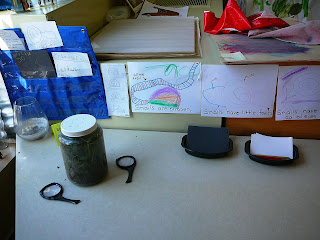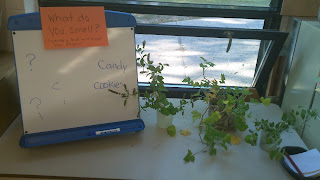Thank you for the commentary posted to the previous blog:
Wondering if you have dug into math learning through the 3 part lesson?
We are wondering what this would look like in our FDK class?
I would frankly have to say that math is an area of our program that I
am not nearly satisfied with. However I am happy to share where I am at in my
rethinking right now.
The Theory
My current key sources have been the Full-Day Early Learning
Kindergarten Program (draft), a fairly hot-off-the-press literature review
about “Mathematics for Young Children”, a Capacity Building Series article “Maximizing
Student Mathematical Learning in the Early Years” and the EduGains.ca video on “Numeracy
Through the Day” (see links below). That information gave me some reassurance,
and some major pressure! Some highlights of my learning through quotes from
some of these sources:
·
Good
math experiences in the early years are vital! Here’s the pressure that is
clear in the literature review undertaken by M4YC:
“There
is ample evidence that a child’s Socioeconomic status (SES) is strongly
predictive of mathematics achievement.” (p.10)
“For
at risk children, early intervention and education, in the form of rich
mathematical experiences, provide the only hope of closing the gap created by
SES differences – a gap that widens without intentional mathematics
intervention.” (p.13)
“Children’s school entry mathematics abilities
were not only consistently predictive of later achievement in mathematics but
in reading as well.” (p.15)
“…robust
studies point to the incredible importance of mathematics learning for young
children to prepare them for school and life success.” (p. 16)
·
We
(educators) need to grow our understanding!
“While
children demonstrate remarkable facility with many aspects of mathematics, many
early childhood teachers do not have a strong mathematical background. At this
time when children’s mathematical potential is great, it is imperative that
early childhood teachers have the competence and confidence to engage
meaningfully with both the children and their mathematics.” (M4YC, p. 18)
·
Most
children come to school with more mathematical knowledge and experience than
previously believed but need “math talk” support to grow that understanding.
“Most
young children come to school already knowing a great deal about mathematics.
Children bring with them an intuitive knowledge of mathematics, which they have
developed through curiosity about their physical world and through real-life
experiences.” (FDELK Draft Program, p. 20)
“By modelling and fostering math talk throughout the day
and across various subject areas, educators can provide the math language that
allows students to articulate their ideas… increase growth in understanding of
mathematical concepts.” (Maximizing Student Mathematical Learning…, p. 4)
·
Mathematics
in the early years classroom requires both math that is found/ provoked/ supported
in children’s play, and also rich mathematical instruction (we seem to think
these are mutually exclusive, when in fact “overlap is natural and desirable”
(M4YC, p. 24):
“Sarama and
Clements suggest that mathematical experiences can be narrowed down into two
forms, play that involves mathematics
and playing with the mathematics itself.”
(Maximizing Student Mathematics… p. 2)
“The
Early Learning–Kindergarten team can create an effective environment to support
young children’s learning of mathematics by planning daily hands-on experiences
that focus on a particular mathematical concept and by identifying and embedding significant mathematics learning
experiences in play, daily routines, and classroom experiences.” (FDELK Draft
Program, p. 21)
“High quality instruction in mathematics and high quality
play need not compete for time in the classroom. Engaging in both makes each
richer and children benefit in every way.” (quotation in EduGains video)
The Practical
Here are a
few ways that we are currently provoking play
that involves mathematics:
1.
Inviting play with math materials
2.
Adding math materials to established play
3.
Acting on the teachable moment in play
4.
Our
presence at centres, when we can build on mathematically-oriented in-the-moment
play and talk.
Sometimes we notice the math happening, sometimes we look
for opportunities to build on mathematical understanding or gaps previously
observed. For example, we have a young JK student, who thinks that counting
should begin with the number three. As a young soul, he also thinks that the
world revolves around him, so I theorize that this obsession with starting counting
at “3”may have to do with the amount of time he spent being three years old as
numbers began to become relevant to his life. To support his development in
play, we have incorporated many opportunities to count, highlight counting and
numbers in his environment. We catch every opportunity we can to have him count,
and notice numbers during his play!
Where we are
currently at with playing with the
mathematics itself:
With
Kindergarten colleagues in my Board a few years ago, we looked at all the
specific math expectations of our K Program, with an eye as to sorting which
ones needed direct instruction through a highly-scripted transmission modelled
math lesson vs. those that could be approached through a problem-solving model.
Even I, who had set the others up for this activity, was amazed at how few we
found that required the former. That made me a stronger believer in a
problem-solving approach.
So what about the “3-Part Lesson?” Rather
than working the math through an instructional practice formula, I consider the
spirit of the elements of this instructional path that are important as we plan
to “play with the mathematics” itself. Our last lesson happened to be a
spontaneous example… all the kids were riveted… it had all the great
characteristics: real-life context, engagement, stemmed from a student’s
comment, and rich, open-ended, higher level math. It not only hit on nearly all
of the numeration expectations as well as some of measurement, geometry and
data management ones, but was also an example of proportional reasoning at its
Kindergarten best, and yet was accessible to all! The problem-solving “How much
toilet paper is enough?” question started with the new toilet paper dispenser
that we received. The new holder ‘rolled toilet paper out’ with much greater
ease and velocity than our previous one. This of course led to the discussion
around our “clogging” issues. Little ‘Jen’ informed us that at their house they
have a rule that “only 3 squares are allowed.” A mathematics 3-Part Lesson was
hatched!
Before/
Getting Started (connect to schema)
How much is 3 squares of our toilet paper?
We asked Jen to get us some, and counted out the squares. We also looked at the
length of 5 and 8 (the amount/distance from dispenser to floor) squares.
During/ Working
On It (problem-solving stage)
Key
Question: How much toilet paper is
enough? To support the thinking, we wadded up a three square strip into
real life usage, and passed it around the group with the questions, “If you were sitting on the toilet, getting
ready to wipe your bottom, does this feel like enough? (We also happen to
be working on visualization as a reading strategy, LOL). Do you need more? A little more? A lot more?
The students
did a Think-Pair-Share and told their partner their opinion and reasons. Students
added their names to the ‘length of their choice.’
After/ Consolidation
(sharing, reflection, highlights, summary)
"What did most people think was enough
toilet paper?" We discussed our results, shared our reasons as
a group, and recorded some of them.
Teacher
Reflection: We want to look for more opportunities like these! The students
were really engaged because the context was very real to them. We could have
made further use of comparing mass by the non-standard “feel” of the crunched
up balls of all three sizes. I would have liked more ‘hands on’ exploration to
it. We could follow up with a post-practical-use survey posted outside the
bathroom door!
“Through active participation in mathematics investigations,
including problem solving and discussions, children develop their ability to
use mathematics as a way of making sense out of their daily experiences.” (FDEL
K Draft Program, p. 96)
Not all of
our lessons happen to be an engaging spontaneous moment of course! I am trying
to keep the idea of problem-solving towards an understanding of a big idea in
the forefront of my mind as I comb resources, real-life contexts, literature,
etc… for jump-points.
This is
where we are at right now… I am sure of more growth as we continue!
Resources:
Full Day Early Learning Kindergarten Program, Draft 2010
Mathematics
for Young Children (M4YC), Literature Review
Maximizing
Student Mathematical Learning in the Early Years, LNS Capacity Building Series,
2011
EduGains.ca,
Kindergarten - “Numeracy Through the Day” video

















